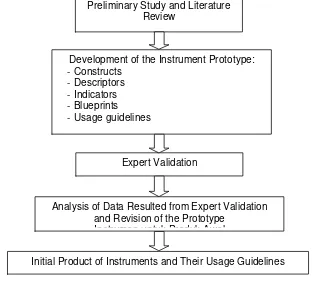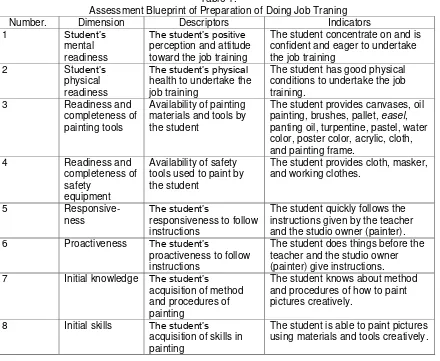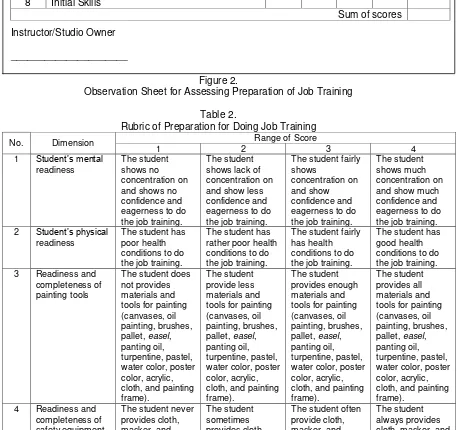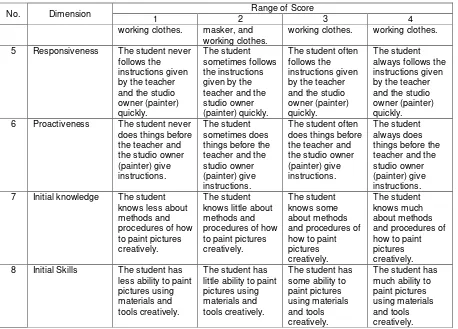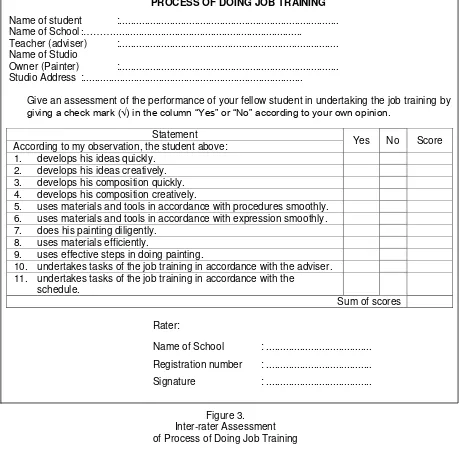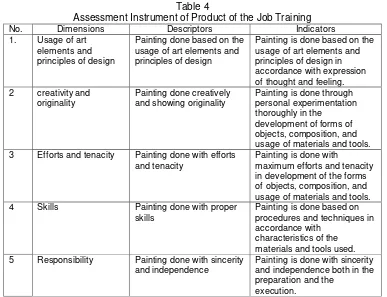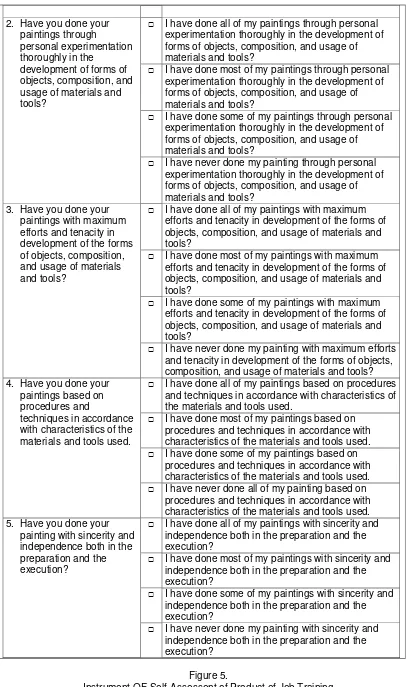International Conference on Educational Research and Evaluation (ICERE) ISSN: 2407-1501
DEVELOPMENT OF ASSESSMENT
INSTRUMENTS OF ART PAINTING RODUCTION
INTEGRATED WITH CHARACTER FOR
ASSESSING LEARNERS’ FIELD WORK PRACTICE
IN VOCATIONAL HIGH SCHOOL
I. INTRODUCTION
A.Background
Education in Indonesia at this time seems more concerned with the mastery of knowledge dimension and tends to ignore the education of values. Consequently the Indonesian people need to generate the commitment and do good character education in families, schools, and communities. This condition and the current situation demands character education that needs to be transformed from an early age, namely from early childhood education, elementary education, secondary education, and higher education in a holistic and sustainable way.
Character education is an investment in cultural values that builds character, morality, and public personality which is taken in a long, continuous, intense, constant, and consistent way. Thus, character education give the students science, knowledge, and cultural practices which is oriented on the values of an ideal life, which are based on local culture (local wisdom) and foreign cultures (Tranggono, 2010: 27)
Our national commitment on the need for character education imperatively stated in Article 3 of Law No. 20 of 2003 on National Education System. It is stated in the Act that "The national education serves to develop the abilities and build character and dignified civilization of the nation in the context of the educating the life of the nation, is aimed at developing students' potentials in order to become a man of faith and fear of God Almighty, noble, healthy, knowledgeable, capable, creative, independent, and become democratic and responsible citizens." If observed, most of the learners’ potentials to develop are closely related to character. Thus, the function and purpose of national education, as mandated by the Act, is not only to develop their knowledge and skills but also the character of the students.
Trie Hartiti Retnowati, Djemari Mardapi, Bambang Prihadi
Yogyakarta State University, trihartiti54@gmail.com, 082121161604
Abstract- The research objective is to develop a set of instruments and scoring guides of nontest assessment for assessing art painting production that are integrated with character assessment in an effort to prepare students of Vocational High School in the face of the world of work. Based on early studies, there are not currently available such instruments and scoring guides as a tool to prepare vocational high school students towards the world of work. This study used the research design and development of Borg and Gall including the following procedures: (1) initial study to find research findings related to the process that will be developed, (2) development of a process based on the findings of the research, (3) field testing in a real situation in which the process will be used, and (4) improvement of instrument products based on the weaknesses found in the field testing. This research resulted in a set of non-test instruments of art painting production integrated with character assessment and scoring guides to assess the creative process and product of vocational high school learners in creating works of painting which can be used to determine their job readiness. In accordance with the existing regulations, non-test assessment is a part of the assessment of learning outcomes of the field work practice in vocational high school.
International Conference on Educational Research and Evaluation (ICERE) ISSN: 2407-1501
The implementation of character education program is integrated into all school subjects, including arts. This principle brings students to learn through the process of thinking, being, and doing. Art education is closely related to character education because of their uniqueness, meaningfulness, and usefulness for developmental needs. Through art lessons the students are given aesthetic experience in the form of art production and art appreciation which includes moral values. Thus, the character building of children with art education in schools can be implemented through such activities in the classroom, so that the role of art education in schools can be as a means to build the learners’ character in order to prepare the 2045 generation.
Vocational High Schools, in accordance with their characteristics, prepare their students to enter the world of work, so that the relevance of their education holds the key importance. Relevance must be interpreted as conformity of competences learned by students with the demands of jobs that will be entered after graduation. Thus, vocational education should be able to anticipate the demands far ahead, starting from the current educational program designed. The curriculum of the vocational education leads to multi skills with strong basic skills, emphasizes the intellectual skills, adaptability and self-training, as well as friendly attitudes towards the local environment (Samani, 1995; End, 1997). Basic skills encompass life skills such as faith and morality, cooperative skills, the ability to explore and process information in facing the situation at hand, problem-solving skills, and the ability to communicate. These abilities are in the affective domain, including characters needed by learners for doing their jobs and living in a society. Thus, it is important to develop character in the learning process. The affective domain is related to attitude, then the measurements to use are non-test instruments. So far, there have been no such instruments and guidelines for assessing the learners’ character in vocational high schools.
In 2011 The Center of Book and Curriculum and the Ministry of Education and Culture issued general guidelines for the implementation of Character Education for schools. In the same year The Junior High School Directorate Development, Directorate of Basic Education and Culture, published the character education operational guidelines to help junior high school teachers implement the character education which are integrated in the learning process for all lessons. Both books are aimed to help teachers implement character education, but they have no instruction how to carry out the assessment of the students’ character development operationally. Although the syllabi developed already contain character items to integrate in the learning process, they do not include operational guidelines for teachers to carry out the assessment of the character development of students. Given the importance of character assessment integrated in learning art, especially painting creation, and the lack of instruments and operational guidelines properly developed, this research is aimed at developing an assessment instrument of painting production integrated with the character, especially in the job training of vocational high school students.
B. Formulation of Reseach Problems
The research problems are formulated as follows:
1. How to develop instruments for accessing painting production integrated with character assessment for the job training of vocational high schools students?
2. How to develop the guidelines to use the assessment instruments for accessing painting production integrated with character assessment for the job training of vocational high schools students?
C. Research Purposes
The purposes of this study are as follows:
1. To develop instruments for accessing painting production integrated with character assessment for the job training of vocational high schools students?
2. To develop the guidelines to use the assessment instruments for accessing painting production integrated with character assessment for the job training of vocational high schools students?
D. Research Signifcance
The benefits of this study are as follows:
1. To provide the institution where the job training is undertaken with non-test instruments and guidelines in assessing students’ performance relating to character.
International Conference on Educational Research and Evaluation (ICERE) ISSN: 2407-1501
3. Provide vocational high school teachers with proper guidelines for assessing the students’ performance in painting production for job.
II. METHODS
This study is a research and development which comprises such steps as follows: (1) the initial study to find research findings related to the product to be developed, (2) the development of products based on the research findings and a literature review, (3) field testing in a real situation in which the product will be used, and (4) improvement of the product based on the weaknesses found in the field test (Borg and Gall, 1983).
The research was conducted with the stages as presented in Figure 1. Firstly, the literature review and the results of previous studies to support the product to be developed i.e. a set of non-test instruments and its implementation guidelines. Secondly, the development of the instruments which comprises the development of the instrument prototype including the constructs, descriptors, indicators, blueprint, and usage guidelines. Thirdly, the Focus Group Discussion (FGD) with such stakeholders as the vocational high school teachers, studio owners or institutions where the job training is conducted, and art experts.
Figure 1.
Development of Non-Test Instruments for Painting Production Assessment Integrated with Character Assessment
Forthly, based on the results of the FGD, the assessment blueprints were discussed and revised and then validated by art education experts from Department of Art Education Faculty of Languages and Arts, Yogyakarta State University. Fourthly, analysis of the validation results and subsequent revision of the instrument prototypes and their usage guidelines as the products of this research.
III. RESULTS AND DISCUSSION
The initial step of the development of assessment instruments of painting production integrated with character assessment for the job training in vocational school was reviewing the relevant theories. The next step was identifying non-test instruments for assessing the painting production stages namely the preparation, the process of painting, and the product of painting. The assessment techniques used for these steps were observation, peer evaluation, and self-assessment respectively which were equipped with rubrics.
Preliminary Study and Literature Review
Development of the Instrument Prototype: - Constructs
- Descriptors - Indicators - Blueprints - Usage guidelines
Expert Validation
Analysis of Data Resulted from Expert Validation and Revision of the Prototype
Instrumen untuk Produk Awal
International Conference on Educational Research and Evaluation (ICERE) ISSN: 2407-1501
In the initial stage, the development of instruments was done by examining the theories underlying the constructs to be assessed so that the instruments would measure what were supposed to be measured. The constructs were then translated into blueprints which included dimensions, descriptions, and indicators. The blueprints were further discussed in Focus Group Discussion (FGD) involving the fine arts teachers of vocational high school in Yogyakarta, art studio owners, and art experts. The blueprints were then revised based on the results of the FGD and validated by art education experts from Department of Art Education, Yogyakarta State University.
The blueprint of the preparation step comprises such dimensions as follows: (1) mental and physical readiness of the student, (2) readiness and completeness of painting tools and safety equipment, (3) responsiveness and proactiveness, and (4) student’s initial knowledge and skills in painting. This blueprint is presented in Table 1.
Table 1.
Assessment Blueprint of Preparation of Doing Job Traning Number. Dimension Descriptors Indicators
1 Student’s
mental readiness
The student’s positive
perception and attitude toward the job training
The student concentrate on and is confident and eager to undertake the job training
2 Student’s
physical readiness
The student’s physical
health to undertake the job training
The student has good physical conditions to undertake the job training.
3 Readiness and completeness of painting tools
Availability of painting materials and tools by the student
The student provides canvases, oil painting, brushes, pallet, easel, panting oil, turpentine, pastel, water color, poster color, acrylic, cloth, and painting frame.
4 Readiness and completeness of safety
equipment
Availability of safety tools used to paint by the student
The student provides cloth, masker, and working clothes.
5 Responsive-ness
The student’s
responsiveness to follow instructions
The student quickly follows the instructions given by the teacher and the studio owner (painter). 6 Proactiveness The student’s
proactiveness to follow instructions
The student does things before the teacher and the studio owner (painter) give instructions. 7 Initial knowledge The student’s
acquisition of method and procedures of painting
The student knows about method and procedures of how to paint pictures creatively.
8 Initial skills The student’s acquisition of skills in painting
The student is able to paint pictures using materials and tools creatively.
International Conference on Educational Research and Evaluation (ICERE) ISSN: 2407-1501
Figure 2.
Observation Sheet for Assessing Preparation of Job Training
Table 2.
Rubric of Preparation for Doing Job Training
No. Dimension Range of Score
1 2 3 4
1 Student’s mental
readiness
2 Student’s physical
readiness
PREPARATION FOR DOING JOB TRAINING
Name of student :...
Based on the observation that you do, give an assessment of the performance of students in the preparation by giving a check mark (√) in the range of scores in accordance with the assessment rubric.
No. Dimension Range of score Score 1 2 3 4
1 Student’s mental readiness 2 Student’s physical readiness
3 Readiness and completeness of painting tools 4 Readiness and completeness of safety
equipment 5 Responsiveness 6 Proactiveness 7 Initial knowledge 8 Initial Skills
Sum of scores Instructor/Studio Owner
International Conference on Educational Research and Evaluation (ICERE) ISSN: 2407-1501
No. Dimension Range of Score
1 2 3 4
working clothes. masker, and
working clothes.
working clothes. working clothes.
5 Responsiveness The student never
follows the
6 Proactiveness The student never
does things before
7 Initial knowledge The student
knows less about
8 Initial Skills The student has
less ability to paint pictures using materials and tools creatively.
The student has little ability to paint pictures using
The result of the observation of the student’s preparation was then graded using the following formula:
Grade = Sum of scores acquired X 100 Maximum score
The second Instrument is used to assess the process of painting. The students’ performance and attitudes during the painting job training comprises such dimensions as follows: (1) development of ideas, (2) expression of the idea through the medium, (3) usage of time, and (4) disiplin. This instrument was made in the form of inter-rater assessment. The dimensions, descriptors, and indicators for this instrument are presented in Table 3. The instrument to assess the process of painting is presented in Figure 4.
Table 3
Assessment Blueprint of Process of Doing Job Training
No. Dimensi Descriptors Indicators
1. Development of
idea
Speed and creativity in developing ideas for painting.
The student develop his ideas to paint pictures quickly and creatively.
2 Expression of the
idea through the medium
The effectiveness of using painting materials and tools.
The student uses painting materials and tools in accordance with the right procedures and his expression.
3 Pemanfatan waktu The efficiency of using time. The student does his painting
smoothly and never wastes time.
4 Discipline Undertaking tasks in job training
accordance with the rules and regulations
International Conference on Educational Research and Evaluation (ICERE) ISSN: 2407-1501
Figure 3. Inter-rater Assessment of Process of Doing Job Training
The result of the inter-rater of the student’s process of the job training is then graded using the following formula:
Grade = Sum of scores acquired X 100 Maximum score
The last instrument is the assessment of product of the job training. To measure the students’ performance in producing works of painting in the job training, the blueprint includes such dimensions as follows: (1) the usage of art elements and principles of design, (2) creativity and originality, (3) efforts and tenacity, (4) skills, and (5) responsibility. This product assessment is made in the form of self-assessment by the students. Table 4 shows the dimensions, descriptors, and an indicators of the assessment of painting products.
INTER-RATER ASSESSMENT INSTRUMENT PROCESS OF DOING JOB TRAINING
Name of student :... Name of School :………...
Teacher (adviser) :... Name of Studio
Owner (Painter) :... Studio Address :...
Give an assessment of the performance of your fellow student in undertaking the job training by
giving a check mark (√) in the column “Yes” or “No” according to your own opinion.
Statement
Yes No Score According to my observation, the student above:
1. develops his ideas quickly. 2. develops his ideas creatively. 3. develops his composition quickly. 4. develops his composition creatively.
5. uses materials and tools in accordance with procedures smoothly. 6. uses materials and tools in accordance with expression smoothly. 7. does his painting diligently.
8. uses materials efficiently.
9. uses effective steps in doing painting.
10. undertakes tasks of the job training in accordance with the adviser. 11. undertakes tasks of the job training in accordance with the
schedule.
Sum of scores
Rater:
International Conference on Educational Research and Evaluation (ICERE) ISSN: 2407-1501
Table 4
Assessment Instrument of Product of the Job Training
No. Dimensions Descriptors Indicators
1. Usage of art
elements and principles of design
Painting done based on the usage of art elements and principles of design
Painting is done based on the usage of art elements and principles of design in accordance with expression of thought and feeling.
2 creativity and
originality
Painting done creatively and showing originality
Painting is done through personal experimentation thoroughly in the
development of forms of objects, composition, and usage of materials and tools.
3 Efforts and tenacity Painting done with efforts
and tenacity
Painting is done with
maximum efforts and tenacity in development of the forms of objects, composition, and usage of materials and tools.
4 Skills Painting done with proper
skills
Painting is done based on procedures and techniques in accordance with
characteristics of the materials and tools used.
5 Responsibility Painting done with sincerity
and independence
Painting is done with sincerity and independence both in the preparation and the
execution.
The instrument of product assessment of painting is made in the form of self-assesment sheet as presented in Figure 5.
SELF-ASSESSMENT INSTRUMENT OF PAINTING PRODUCT
Name of student :... Name of School :………... Teacher (adviser) :... Name of Studio
Owner (Painter) :... Studio Address :...
Answer the following questions by giving a check mark (√) in the box according to your own opinion.
1. Have you done your paintings using art
elements and principles of design in accordance with expression of thought and feeling?
□ I have done all my paintings with awareness of the usage of art elements and principles of design in accordance with expression of thought and feeling?
□ I have done most of my paintings based on awareness of the usage of art elements and principles of design in accordance with expression of thought and feeling?
□ I have done some of my paintings based awareness of the usage of art elements and principles of design in accordance with expression of thought and feeling?
International Conference on Educational Research and Evaluation (ICERE) ISSN: 2407-1501
2. Have you done your paintings through
personal experimentation thoroughly in the
development of forms of objects, composition, and usage of materials and tools?
□ I have done all of my paintings through personal experimentation thoroughly in the development of forms of objects, composition, and usage of materials and tools?
□ I have done most of my paintings through personal experimentation thoroughly in the development of forms of objects, composition, and usage of materials and tools?
□ I have done some of my paintings through personal experimentation thoroughly in the development of forms of objects, composition, and usage of materials and tools?
□ I have never done my painting through personal experimentation thoroughly in the development of forms of objects, composition, and usage of materials and tools?
3. Have you done your paintings with maximum efforts and tenacity in development of the forms of objects, composition, and usage of materials and tools?
□ I have done all of my paintings with maximum efforts and tenacity in development of the forms of objects, composition, and usage of materials and tools?
□ I have done most of my paintings with maximum efforts and tenacity in development of the forms of objects, composition, and usage of materials and tools?
□ I have done some of my paintings with maximum efforts and tenacity in development of the forms of objects, composition, and usage of materials and tools?
□ I have never done my painting with maximum efforts and tenacity in development of the forms of objects, composition, and usage of materials and tools? 4. Have you done your
paintings based on procedures and
techniques in accordance with characteristics of the materials and tools used.
□ I have done all of my paintings based on procedures and techniques in accordance with characteristics of the materials and tools used.
□ I have done most of my paintings based on procedures and techniques in accordance with characteristics of the materials and tools used.
□ I have done some of my paintings based on procedures and techniques in accordance with characteristics of the materials and tools used.
□ I have never done all of my painting based on procedures and techniques in accordance with characteristics of the materials and tools used. 5. Have you done your
painting with sincerity and independence both in the preparation and the execution?
□ I have done all of my paintings with sincerity and independence both in the preparation and the execution?
□ I have done most of my paintings with sincerity and independence both in the preparation and the execution?
□ I have done some of my paintings with sincerity and independence both in the preparation and the execution?
□ I have never done my painting with sincerity and independence both in the preparation and the execution?
Figure 5.
International Conference on Educational Research and Evaluation (ICERE) ISSN: 2407-1501
The result of the self-assessment of the student’s product of the job training is then graded using the following formula:
Grade = Sum of scores acquired X 100 Maximum score
The instruments of preparation, process, and product of the painting job training by the students of vocational high school equipped with the guidelines for their usage are packed in a book which is ready to be tested further in the real setting.
IV. CONCLUSIONS AND SUGGESTIONS
A. Conclusions:
The conclusions of this study are as follows:
1. The establishment of a set non-test instruments for assessing the painting job training by the students of vocational high school which are integrated with the character assessment.
2. The establishment of guidelines for the usage of the non-test instruments for assessing the painting job training by the students of vocational high school which are integrated with the character assessment.
B. Suggestions:
1. The non-test instruments for assessing the painting job training by the students of vocational high school integrated with the character assessment should be tested in terms of readability by the teachers (advisers) as well as the instructors or studio owners (painters).
2. Support of administration will be needed to conduct the limited test of the instruments.
BIBLIOGRAPHY
[1] Borg, W.R. and Gall, M.D. (1983). Educational Research: An Introduction. London: Longman, Inc.
[2] Samani, Muchlas dan Hariyanto (2011). Konsep dan Model Pendidikan Karakter, Bandung: PT Remaja
Rosda Karya.
[3] Tranggono, Indra. (26 April 2010), Pendidikan Karakter. Kedaulatan Rakyat .
